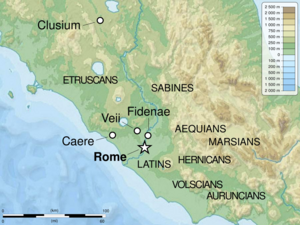Aequi facts for kids
The Aequi were an ancient tribe who lived in the Apennine Mountains of central Italy. They were neighbors of early ancient Rome. The Aequi often fought against Rome for their independence. Eventually, they were defeated, and Rome established many new towns on their land.
We know very little about the Aequian language. Only two short writings are left, and they show it was an Italic language, similar to Latin. Most writings found in their old territory are in Latin, made by Roman settlers. The Romans called these settlers "Aequi" or "Aequicoli," meaning "colonists of Aequium."
Where Did the Aequi Live?
Ancient historians wrote a lot about the wars between the Aequi and Rome. However, geographers didn't say much about where they lived. Pliny the Elder and Ptolemy briefly mentioned two towns of the Aequiculi: Cliternia and Carsoli. By the time of the early Roman Empire, the original Aequi tribe had disappeared. The towns they once lived in became Roman colonies.
The Aequi lived in the upper parts of river valleys, including the Aniene, Tolenus, and Himella rivers. These last two were mountain streams that flowed north into the Nera river.
Aequi History and Wars with Rome
According to the ancient writer Strabo, the Aequi were already living in Italy when the city of Rome was founded. The Roman historian Livy first mentioned them as an old nation from whom the Romans learned how to declare war. Livy also wrote that Tarquinius Superbus, the last king of Rome, made peace with the Aequi.
The Aequi fought many wars against the Romans. One famous battle was the Battle of Mount Algidus in 458 BC. Their main town was captured by the Romans around 484 BC, and again about 90 years later. After the mid-400s BC, there were fewer records of fighting between the Romans and the Aequi. This probably means the Aequi became more settled and stopped their raids.
In 390 BC, a group of Gauls defeated the Roman army and then attacked Rome itself. Ancient writers say that in 389 BC, the Etruscans, Volsci, and Aequi all gathered armies. They hoped to take advantage of Rome's weakness. According to Livy, the Aequi gathered their army at Bolae. However, the Roman leader, Marcus Furius Camillus, surprised the Aequian army. He captured their camp and the town. Some sources say the Aequi were actually attacking Bolae when Camillus attacked them. A Roman army also raided Aequian land in 388 BC, facing no resistance.
The Aequi were finally brought under Roman control at the end of the second Samnite War. After this, they were given some rights as Roman citizens.
Later, after the Social War, the people of Cliternia and Nersae joined together to form a "res publica Aequiculorum." This was a type of Roman town called a municipium. It was located in what is now the area of Pescorocchiano. The Roman colonies of Alba Fucens (founded in 304 BC) and Carsioli (founded in 298 BC) helped spread the Latin language throughout the region. The main road to the south, the Via Valeria, passed through this area.
By the end of the Roman Republic, the Aequi were known as Aequiculi or Aequicoli. They were organized as a Roman municipium. Their territory included the upper part of the Salto valley, which is still called Cicolano today. It is likely that they continued to live in their villages, with Nersae (modern Civitella di Nesce) being the largest. You can still see remains of large stone walls there.


